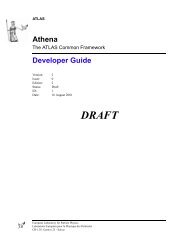2007 - Physics and Astronomy - University of South Carolina
2007 - Physics and Astronomy - University of South Carolina
2007 - Physics and Astronomy - University of South Carolina
You also want an ePaper? Increase the reach of your titles
YUMPU automatically turns print PDFs into web optimized ePapers that Google loves.
Department News<br />
Pictured on the far left is Jeff Wilson, instructing middle school teachers.<br />
A <strong>Physics</strong> Phenomenon<br />
for Middle School Teachers<br />
For the past three summers, Pr<strong>of</strong>essor Jeff Wilson has<br />
instructed middle school teachers in the finer points<br />
<strong>of</strong> work <strong>and</strong> energy, using simple machines as concrete<br />
examples. The teachers are introduced to physics in a “phenomenon<br />
first” environment, basically by seeing a principle<br />
<strong>of</strong> physics at work before attempting to explain it. They are<br />
given an example <strong>of</strong> a simple machine, <strong>and</strong> they use the<br />
scientific method to gather data <strong>and</strong> use the data to explain<br />
how the machine works. Undergraduate physics students<br />
would recognize the activities as being based on some <strong>of</strong><br />
the classic physics demos—inclined planes, levers, <strong>and</strong> pulleys.<br />
A strange feature <strong>of</strong> this teaching method is that when<br />
it works well, the students are very engaged in the activity<br />
<strong>and</strong> the instructor may seem to be unnecessary.<br />
The Summer Institute is a multidisciplinary endeavor<br />
involving Christine Lotter from the College <strong>of</strong> Education,<br />
Bob Feller from the Center for Science Education, Dave<br />
Barbeau from geology, <strong>and</strong> Jeff Wilson from physics. The<br />
institute was started by Jon Singer <strong>of</strong> the College <strong>of</strong> Education<br />
in order to give middle school teachers the content<br />
knowledge necessary to teach the science topics required<br />
by <strong>South</strong> <strong>Carolina</strong>. One very important feature is that it is<br />
integrated with a local middle school’s summer program<br />
<strong>and</strong> uses real middle school students as subjects. The Summer<br />
Institute manages to be an enrichment program on<br />
many levels.<br />
The BIG “R”<br />
By Ronald D. Edge<br />
What do you do after you retire? Boredom! Well, I found that I was<br />
busier after retiring than before. There were all those things that<br />
I wanted to do but never had time. The big advantage was that I<br />
did not have to attend faculty meetings. No more <strong>of</strong> those tedious<br />
debates about insignificant events. Why are faculty meetings so contentious?...<br />
Because the stakes are so small.<br />
Anyway, I had always wanted to spend more time on my hobby,<br />
church bell ringing. You might wonder what the connection is<br />
between bell ringing <strong>and</strong> physics, but apart from the motion <strong>of</strong> the<br />
bells themselves, about which there is quite a lot <strong>of</strong> engineering <strong>and</strong><br />
mathematics, <strong>and</strong> the acoustics—my friend Tom Rossing has written<br />
books about that (he was originally into drum acoustics, but has<br />
lovely laser interference pictures <strong>of</strong> bells <strong>and</strong> ancient Chinese gongs<br />
sounding)—there is the theory <strong>of</strong> the changes themselves. Church<br />
bells weigh tons, <strong>and</strong> ringing by rope without hanging yourself is<br />
quite a skill. In physics, we know Galileo showed the period was<br />
constant—but only for small oscillations. Ringers swing the bell<br />
through 360 degrees, upside down to upside down. The solution<br />
to this motion is an elliptic integral. Even in practice, it is difficult<br />
to change the period much. In ringing, the bells strike sequentially,<br />
with eight bells in an octave, one ringer per bell. They can be shifted<br />
one place at a time, each time they ring, so we might move from<br />
12345678 to 21436587. This is called a “change.” There are factorial<br />
seven changes on seven bells, 5040, <strong>and</strong> a peal consists <strong>of</strong> ringing<br />
all <strong>of</strong> these without mistake. It takes about three hours, <strong>and</strong> there<br />
are still problems existing in peal construction. Only recently has a<br />
peal <strong>of</strong> Stedman (a principle <strong>of</strong> ringing) been constructed without<br />
“singles” (which change the permutations from odd to even) by a<br />
ringing friend <strong>of</strong> mine employing a powerful IBM computer. When I<br />
immigrated here, there were no bells south <strong>of</strong> Boston. Now there are<br />
more than a dozen rings—two in Washington, D.C., itself (the bells<br />
<strong>of</strong> the cathedral are the highest point in Washington, <strong>and</strong> the bells in<br />
the Old Post Office Tower on the Mall were a bicentennial gift from<br />
Engl<strong>and</strong>), <strong>and</strong> four in Charleston—starting with St. Michael’s, where<br />
the bells had not been rung for well over a hundred years (after the<br />
war between the states). Many peals have been rung in Charleston<br />
since the bells were rehung. I found most <strong>of</strong> the ringers at the old<br />
North Church in Boston (Paul Revere rang there) are women physics<br />
students from MIT. New York City received its first ring <strong>of</strong> bells<br />
(Trinity Church on Wall street) a couple <strong>of</strong> months ago.<br />
Retirement gives the ability to delve into problems with no financial<br />
support. I had always been interested in the physics <strong>of</strong> surfing, but no<br />
federal agency would give you a grant to go <strong>of</strong>f to Hawaii to investigate<br />
it. I wrote the first physics article on surfing for the <strong>Physics</strong><br />
Teacher, <strong>and</strong> there was quite a lot <strong>of</strong> interest. My last article was on<br />
the downdraft from a helicopter.<br />
15
















